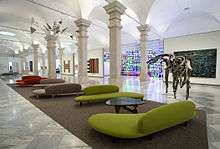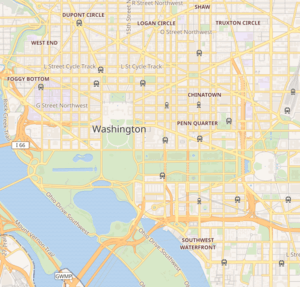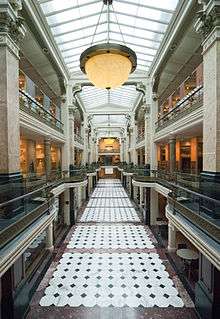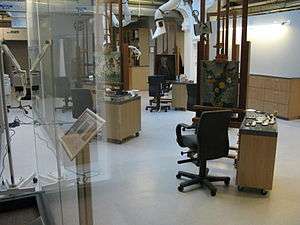Smithsonian American Art Museum
The Smithsonian American Art Museum (commonly known as SAAM, and formerly the National Museum of American Art) is a museum in Washington, D.C., part of the Smithsonian Institution. Together with its branch museum, the Renwick Gallery, SAAM holds one of the world's largest and most inclusive collections of art, from the colonial period to the present, made in the United States. The museum has more than 7,000 artists represented in the collection. Most exhibitions take place in the museum's main building, the old Patent Office Building (shared with the National Portrait Gallery), while craft-focused exhibitions are shown in the Renwick Gallery.
 Lincoln Gallery | |
 Location in Washington, D.C. | |
| Established | 1829[1] |
|---|---|
| Location | 8th & F Streets NW, Washington, D.C.[2] |
| Coordinates | 38°53′52″N 77°01′24″W |
| Type | Art museum, Design/Textile Museum, Heritage Museum[3] |
| Visitors | 1.2 million (2013)[4] |
| Director | Stephanie Stebich (as of April 2017)[5][6][7][8] |
| Curator | Virginia M. Mecklenburg[9] Nora Atkinson Saisha Grayson Melissa Ho Eleanor Jones Harvey John P. Jacob Karen Lemmey Crawford Alexander Mann III Joanna Marsh Sarah Newman E. Carmen Ramos Leslie Umberger |
| Public transit access | |
| Website | americanart.si.edu |
The museum provides electronic resources to schools and the public through its national education program. It maintains seven online research databases with more than 500,000 records, including the Inventories of American Painting and Sculpture that document more than 400,000 artworks in public and private collections worldwide. Since 1951, the museum has maintained a traveling exhibition program; as of 2013, more than 2.5 million visitors have seen the exhibitions.
History
The Smithsonian American Art Museum has had many names over the years—Smithsonian Art Collection, National Gallery of Art (not to be confused with the current National Gallery of Art), National Collection of Fine Arts, and National Museum of American Art.[10] The museum adopted its current name in October 2000.[11]
The collection, which was begun in 1829, was first on display in the original Smithsonian Building, now nicknamed the "Castle". The collection grew as the Smithsonian buildings grew, and the collection was housed in one or more Smithsonian buildings on the National Mall.[4] By the 1920s, space had become critical: "Collections to the value of several millions of dollars are in storage or temporarily on exhibition and are crowding out important exhibits and producing a congested condition in the Natural History, Industrial Arts, and Smithsonian Buildings".[12] In 1924, architect Charles A. Platt – who designed the 1918 Freer Gallery for the Smithsonian – drew up preliminary plans for a National Gallery of Art to be built on the block next to the Natural History Museum.[12] However, this building was never constructed.[13]
The Smithsonian American Art Museum first opened to the public in its current location in 1968 when the Smithsonian renovated the Old Patent Office Building in order to display its collection of fine art. American Art's main building, the Old Patent Office Building, is a National Historic Landmark located in Washington, D.C.'s downtown cultural district. An example of Greek Revival architecture,[14][15] it was designed by architects Robert Mills[16] and Thomas U. Walter.
During the 1990s, the Smithsonian Institution worked on restoring the building.[17]
The Smithsonian completed another renovation of the building in July 1, 2006.[10] The 2000-2006 renovation restored many of the building's exceptional architectural features: restoring the porticos modeled after the Parthenon in Athens, a curving double staircase, colonnades, vaulted galleries, large windows, and skylights as long as a city block.[10][17][8] During the renovation, the Lunder Conservation Center, the Luce Foundation Center for American Art, Nan Tucker McEvoy Auditorium, and the Robert and Arlene Kogod Courtyard were added to the building.[17]
In 2008, the American Alliance of Museums awarded reaccreditation to the Smithsonian American Art Museum.[18]

Affiliated museums
National Portrait Gallery
The Smithsonian American Art Museum shares the historic Old Patent Office building with the National Portrait Gallery, another Smithsonian museum. Although the two museums' names have not changed, they are collectively known as the Donald W. Reynolds Center for American Art and Portraiture.[10][19]
Renwick Gallery
Also under the auspices of the Smithsonian American Art Museum, the Renwick Gallery is a smaller, historic building on Pennsylvania Avenue across the street from the White House.[20] The building originally housed the collection of the Corcoran Gallery of Art.[20][21] In addition to displaying a large collection of American contemporary craft, several hundred paintings from the museum's permanent collection — hung salon style: one-atop-another and side-by-side — are featured in special installations in the Grand Salon.[20]
Features and programs
Collections
Part of the Smithsonian Institution, the museum has a broad variety of American art, with more than 7,000 artists represented,[22] that covers all regions and art movements found in the United States. SAAM contains the world's largest collection of New Deal art; a collection of contemporary craft, American impressionist paintings, and masterpieces from the Gilded Age; photography, modern folk art, works by African American and Latino artists, images of western expansion, and realist art from the first half of the twentieth century. Among the significant artists represented in its collection are Nam June Paik, Jenny Holzer, David Hockney, Georgia O'Keeffe, John Singer Sargent, Albert Pinkham Ryder, Albert Bierstadt, Edmonia Lewis, Thomas Moran, James Gill, Edward Hopper, John William "Uncle Jack" Dey, Karen LaMonte[23] and Winslow Homer.[4]
SAAM describes itself as being "dedicated to collecting, understanding, and enjoying American art. The museum celebrates the extraordinary creativity of artists whose works reflect the American experience and global connections."[24]
Galleries and public spaces
The American Art's main building contains expanded permanent-collection galleries and public spaces.[25] The museum has two innovative public spaces. The Luce Foundation Center for American Art is a visible art storage and study center, which allows visitors to browse more than 3,300 works of the collection.[25] The Lunder Conservation Center is "the first art conservation facility to allow the public permanent behind-the-scenes views of the preservation work of museums".[25]
The Luce Foundation Center for American Art

The Luce Foundation Center, which opened in July 2000,[26][27] is the first visible art storage and study center in Washington, D.C.[10] and the fourth center to bear the Luce Family name.[10][28] It has 20,400 square feet on the third and fourth floors of American Art Museum.[10][29][30][31]
It presents more than 3,300 objects in 64 secure glass cases, which quadruples the number of artworks from the permanent collection on public view.[26][10] The purpose of open storage is to allow patrons to view various niche art that is usually not part of a main exhibition or gala special.[29] The Luce Foundation Center features paintings densely hung on screens; sculptures; crafts and objects by folk and self-taught artists arranged on shelves.[32][33] Large-scale sculptures are installed on the first floor.[26] The Center has John Gellatly's European collection of decorative arts.[10][31]
Lunder Conservation Center

The Lunder Conservation Center, which opened in July 2000,[34] is the first art conservation facility that allows the public permanent behind-the-scenes views of preservation work.[34] Conservation staff are visible to the public through floor-to-ceiling glass walls that allow visitors to see firsthand all the techniques which conservators use to examine, treat, and preserve artworks.[35][34][36] The Lunder Center has five conservation laboratories and studios equipped to treat paintings, prints, drawings, photographs, sculptures, folk art objects, contemporary crafts, decorative arts, and frames.[35][34] The Center uses various specialized and esoteric tools, such as hygrothermographs, to maintain optimal temperature and humidity to preserve works of art. Staff from both the Smithsonian American Art Museum and the National Portrait Gallery work in the Lunder Center.[34]
Selected exhibitions
The museum has put on hundreds of exhibitions since its founding. Many exhibitions are groundbreaking and promote new scholarship within the field of American art.
What follows is a brief list of selected, and more recent, examples:[37]
- Ginny Ruffner: Reforestation of the Imagination (2019-2020)
- Michael Sherrill Retrospective (2019-2020)
- American Myth & Memory: David Levinthal Photographs (2019-2019)
- Artists Respond: American Art and the Vietnam War, 1965-1975 (2019-2019)
- Disrupting Craft: Renwick Invitational 2018 (2018-2019)
- Between Worlds: The Art of Bill Traylor (2018-2019)
- Trevor Paglen: Sites Unseen[38] (2018-2019)
- Diane Arbus: A box of ten photographs[39] (2018-2019)
- No Spectators: The Art of Burning Man[40] (2018-2019)
- Do Ho Suh: Almost Home[41] (2018)
- Tamayo: The New York Years[42] (2017-2018)
- Murder Is Her Hobby: Frances Glessner Lee and The Nutshell Studies of Unexplained Death[43] (2017-2018)
- Kara Walker: Harper’s Pictorial History of the Civil War (Annotated)[44] (2017-2018)
- Down These Mean Streets: Community and Place in Urban Photography[45] (2017)
- June Schwarcz: Invention and Variation[46] (2017)
- Gene Davis: Hot Beat[47] (2016-2017)
- Isamu Noguchi, Archaic/Modern[48] (2016-2017)
- Harlem Heroes: Photographs by Carl Van Vechten[49] (2016-2017)
- Visions and Revisions: Renwick Invitational 2016[50] (2016)
- Artworks by African Americans from the Collection[51] (2016)
- The Art of Romaine Brooks[52] (2016)
- Ralph Fasanella: Lest We Forget (2014)
- Modern American Realism: The Sara Roby Foundation Collection (2014)
- Pop Art Prints (2014)
- Our America: The Latino Presence in American Art (2013)
- Landscapes In Passing: Photographs by Steve Fitch, Robbert Flick, and Elaine Mayes (2013)
- A Democracy of Images: Photographs from the Smithsonian American Art Museum (2013)
- Nam June Paik: Global Visionary (2012)
- The Civil War and American Art (2012)
- 40 under 40: Craft Futures (2012)
- African American Art: Harlem Renaissance, Civil Rights Era, and Beyond (2012)
- The Art of Video Games (2012)
- Annie Leibovitz: Pilgrimage (2011)
- Multiplicity (2011)
- The Great American Hall of Wonders (2011)
- Something of Splendor: Decorative Arts from the White House (2011)
- Alexis Rockman - A Fable for Tomorrow (2010)
- The West As America (1991)
Outreach
The museum has maintained a traveling exhibition program since 1951. During the 2000s renovation, a "series of exhibitions of more than 1,000 major artworks from American Art's permanent collection traveled to 105 venues across the United States," which were "seen by more than 2.5 million visitors". Since 2006, thirteen exhibitions have toured to more than 30 cities.[53]
SAAM provides electronic resources to schools and the public as part of education programs. An example is Artful Connections, which gives real-time video conference tours of American Art. In addition, the museum offers the Summer Institutes: Teaching the Humanities through Art, week-long professional development workshops that introduce educators to methods for incorporating American art and technology into their humanities curricula.[54]
American Art has seven online research databases, which has more than 500,000 records of artworks in public and private collections worldwide, including the Inventories of American Painting and Sculpture. Numerous researchers and millions of virtual visitors per year use these databases. Also, American Art and Heritage Preservation work together in a joint project, Save Outdoor Sculpture, "dedicated to the documentation and preservation of outdoor sculpture". The museum produces a peer-reviewed periodical, American Art (started in 1987), for new scholarship. Since 1993, American Art has been had an online presence. It has one of the earliest museum websites when, in 1995, it launched its own website. EyeLevel, the first blog at the Smithsonian Institution, was started in 2005 and, as of 2013, the blog "has approximately 12,000 readers each month".[55]
In popular culture
President Abraham Lincoln held his inaugural ball in the gallery currently called the Lincoln Gallery.[8]
In 2006, fashion designer Isaac Mizrahi designed the conservators' denim work aprons.[36][56][57]
In 2008, the American Art Museum hosted an alternate reality game, called Ghosts of a Chance, which was created by City Mystery. The game allowed patrons "a new way of engaging with the collection" in the Luce Foundation Center. The game ran for six weeks and attracted more than 6,000 participants.[31]
References
- "Museum History". Smithsonian Institution. Archived from the original on August 20, 2014. Retrieved May 11, 2014.
- Calos, Katherine. "Heads will turn". Times-Dispatch.
- "Smithsonian American Art Museum: About". ARTINFO. 2008. Retrieved 2008-07-30. Cite journal requires
|journal=(help) - "Smithsonian American Art Museum Fact Sheet, February 2014". Smithsonian Institution. Retrieved May 11, 2014.
- Durón, Maximilíano (January 24, 2017). "Smithsonian American Art Museum Names Stephanie Stebich Director". ARTnews. Retrieved 28 March 2017.
- McGlone, Peggy (January 24, 2017). "Smithsonian American Art appoints Tacoma Art Museum director". The Washington Post. ISSN 0190-8286. Retrieved 2017-05-03.
- "Smithsonian American Art Museum Staff Bios". Smithsonian Institution. Retrieved December 31, 2009.
- Neary, Lynn (13 April 2006). "D.C. Museums Near End of Pricey Facelift". All Things Considered. NPR. Retrieved 2 April 2013.
- "Smithsonian American Art Museum Staff Bios". Smithsonian Institution. Retrieved March 28, 2017.
- O'Rourke, Ronald. "Through a Glass More Clearly". Architecture DC.
- sysadmin (2000-10-27). "National Museum of American Art (NMAA) renamed Smithsonian American Art Museum (SAAM), October 27, 2000". Smithsonian Institution Archives (Press release). Retrieved 2018-01-30.
- Proceedings of the Board of Regents of the Smithsonian Institution at the Adjourned Meeting held Monday, January 5, 1925, Washington, D.C.: Smithsonian Institution, January 5, 1925, pp. 654–655
- "SIA RU000092, Smithsonian Institution, Prints and Drawings, 1840-". Smithsonian Institution. Retrieved January 30, 2018.
Also included are... copies of drawings for the proposed National Gallery of Art (never constructed) by Charles A. Platt, 1924....
- Houston, Susan (July 27, 2006). "Capital faces and places". The News and Observer.
- "District of Columbia - Inventory of Historic Sites" (PDF). District of Columbia: Office of Planning. Government of the District of Columbia. September 1, 2004. Archived from the original (PDF) on July 17, 2009. Retrieved September 22, 2009.
- "Smithsonian puts art in a new light". Gainesville Sun. July 9, 2006.
- "About the American Art Museum and the Renwick Gallery". Smithsonian Institution. Retrieved 15 March 2013.
- "Fact Sheet Smithsonian American Art Museum" (PDF). Smithsonian Institution. Retrieved 15 March 2013.
- Harvey, Eleanor (July 2006). "The New Smithsonian American Art Museum". The Magazine Antiques. p. 76.
- "Architectural History of the Renwick Gallery". Smithsonian Institution. Archived from the original on 2004-04-30.
- Reed, Robert (1980). Old Washington, D.C. in Early Photographs: 1846-1932. Dover Publications. p. 127. ISBN 9780486138541.
- "Smithsonian American Art Museum" (PDF). Smithsonian Institution. March 2012. Retrieved 29 March 2013.
- Bell, Nicholas. "In Conversation: Nicholas Bell on Karen LaMonte". Smithsonian American Art Museum.
- Smithsonian American Art Museum's Strategic Plan, 2012-2016
- "About the American Art Museum and the Renwick Gallery". Smithsonian Institution. Retrieved 15 March 2013.
- Howard, Hilary (July 9, 2006). "Comings and Goings". The New York Times.
- Hettger, Henry T. (September 12, 2006). "De Franccisci featured in Luce Foundation". Numismatic News. Missing or empty
|url=(help) - Sherry, Karen A. (2006). "The Luce Center for American Art". American Art Review. XVIII (1): 112.
- Gopnik, Blake (December 31, 2010). "Museum 'Closets' That Have Plenty In Store for Visitors". The Washington Post. p. N3. Retrieved 6 April 2018.
- Vogel, Carol (July 2, 2004). "A Festive touch in Festive colors". The New York Times. Retrieved 6 April 2018.
- Baptiste, Laura (April 2009). "Luce Foundation Center for American Art Fact Sheet" (PDF). Smithsonian Institution. Retrieved 29 March 2013.
- Trescott, Jacqueline. "A Walk-In Closet for All". The Washington Post. Retrieved 6 April 2018.
- Lipske, Michael (Winter 2004). "Medal collection occupies interesting realm between art and currency".
- Terhune, Lea (August 7, 2006). "Lunder Conversation Center allows visitors to see conservators at work". USInfo at State.gov.
- "Gallery Reopens with Unique Education and Conservation Centers". Arts Washington. September–October 2006.
- Macadam, Alison (30 June 2006). "Art Conservators at Work: A Living Exhibit". All Things Considered. NPR. Retrieved 6 April 2018.
- "Past exhibitions". Smithsonian Institution. Retrieved 12 May 2014.
- "Trevor Paglen: Sites Unseen". Smithsonian American Art Museum.
- "Diane Arbus: A box of ten photographs". Smithsonian American Art Museum.
- "No Spectators: The Art of Burning Man". Smithsonian American Art Museum.
- "Do Ho Such: Almost Home". Smithsonian American Art Museum.
- "Tamayo: The New York Years". Smithsonian American Art Museum.
- "Murder Is Her Hobby: Frances Glessner Lee and The Nutshell Studies of Unexplained Death". Smithsonian American Art Museum.
- "Kara Walker: Harper's Pictorial History of the Civil War (Annotated)". Smithsonian American Art Museum.
- "Down These Mean Streets: Community and Place in Urban Photography". Smithsonian American Art Museum.
- "June Schwarcz: Invention and Variation". Smithsonian American Art Museum.
- "Gene Davis: Hot Beat". Smithsonian American Art Museum.
- "Isamu Noguchi, Archaic/Modern". Smithsonian American Art Museum.
- "Harlem Heroes: Photographs by Carl Van Vechten". Smithsonian American Art Museum.
- "Visions and Revisions: Renwick Invitational 2016". Smithsonian American Art Museum.
- "Artworks by African Americans from the Collection". Smithsonian American Art Museum.
- "The Art of Romaine Brooks". Smithsonian American Art Museum.
- "National Outreach". Smithsonian Institution. Retrieved 15 March 2013.
- "Education Outreach". Smithsonian Institution. Retrieved 15 March 2013.
- "National Outreach". Retrieved 15 March 2013.
- Taylor, Caroline (July 2006). "New features fill Reynolds Center". The Torch.
- Choi, Amy S. (June 30, 2006). "Smithsonian Staff to Don Mizrahi Aprons". Women's Wear Daily. p. 27. Retrieved 2 April 2013.
External links
| Wikimedia Commons has media related to Smithsonian American Art Museum. |
- Official website
- Luce Foundation Center at SAAM
- Lunder Conservation Center at SAAM
- Rosenbaum, Lee (Aug 29, 2006). "Smithsonian American Art Museum". Wall Street Journal.